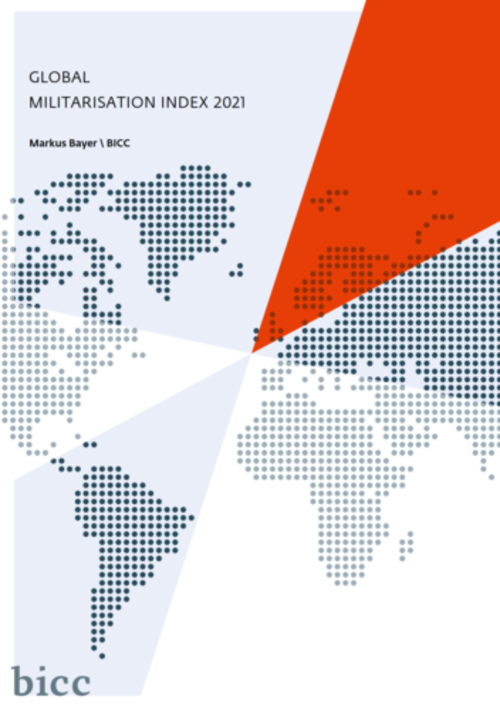Publications
Global Militarisation Index 2021
Release Date
2022
Language
- English
- German
Topics
- –
Every year, bicc’s Global Militarisation Index (GMI) maps the relative weight and importance of a country’s military apparatus in relation to its society as a whole. The GMI 2021 is an anniversary edition. Its first part reflects, as usual, current developments and trends based on the latest available data. It covers 153 countries and is based on the latest available figures (in most cases, data for 2020).
The ten countries with the highest levels of militarisation in the GMI 2021 are Israel, Oman, Azerbaijan, Kuwait, Armenia, Saudi Arabia, Brunei, Bahrain, Singapore and Russia. These countries allocate particularly high levels of resources to the military compared to other areas of society.
Besides countries primarily from conflict regions in the Middle East, three European countries can also be found here, all of which are involved in violent conflicts. A further three—Greece and Cyprus, both EU member states, and Ukraine—are among the top 20. In the regional focus on Europe, one overall trend of the GMI 2021 becomes particularly clear: Despite the decrease in global GDP as a result of the COVID-19 pandemic, countries are spending more resources on the military in absolute terms and as a proportion of their economic output.
Another regional focus this time is on Sub-Saharan Africa. In West Africa, in particular, the security situation has deteriorated dramatically over the past few years. Therefore, it is particularly interesting to look at the dynamics of militarisation on that continent. Alongside relatively stable countries, such as Botswana, Namibia, Mauritania, Angola, Gabon and Guinea-Bissau, countries with current violent conflicts, such as Chad, South Sudan and Mali, can be found among the top 10.
The second part of the GMI looks at the global and regional development of militarisation over the past 20 years. This overall view of global militarisation between 2000 and 2020 shows that, except for an interim peak in 2005, it initially decreased steadily. Our resource-based concept of militarisation explains this as follows: It is due to the increase in the world’s population and that of global financial resources, which cause the proportion of the military sector in the GMI to decrease from 2000 to 2018. This, however, does not imply “true demilitarisation”, as is evidenced by the absolute increase in military spending over the period under review (SIPRI, 2020). Since 2019, this trend has reversed again. In the past two years, rising militarisation can be observed again across the globe, mainly because the resources allocated to the military are increasing in absolute and in relative terms.
The Index is financially supported by Germany’s Federal Ministry for Economic Cooperation and Development.
PDF-Download

PDF-Download

Cite as
Document-Type
BICC Global Militarization Index
Publisher
bicc
Place
Bonn



